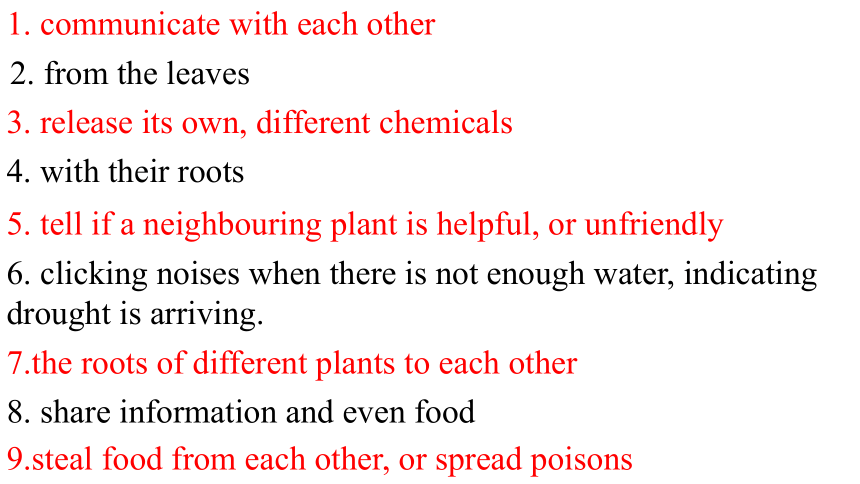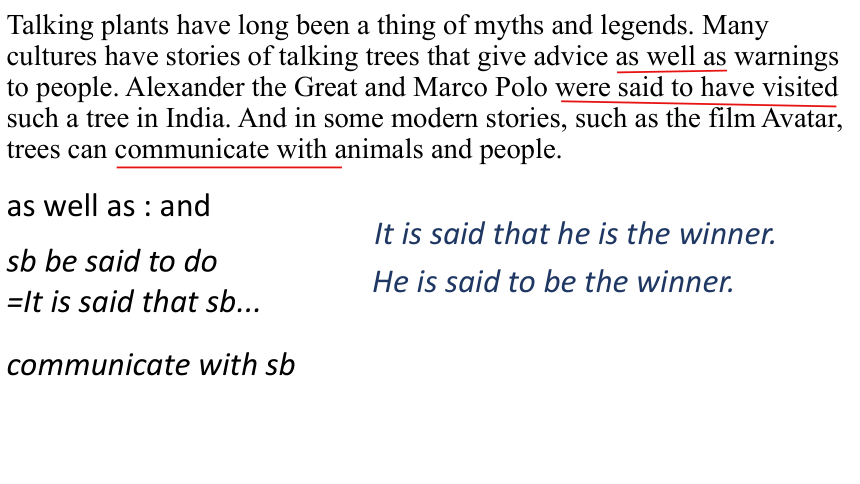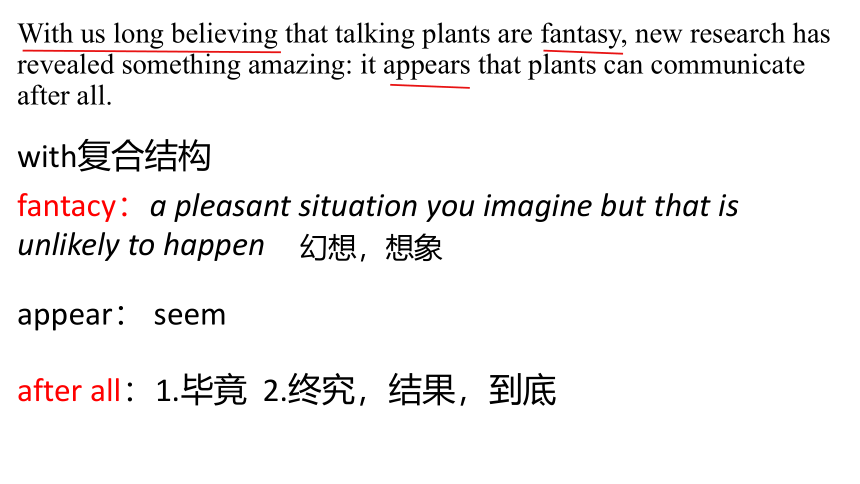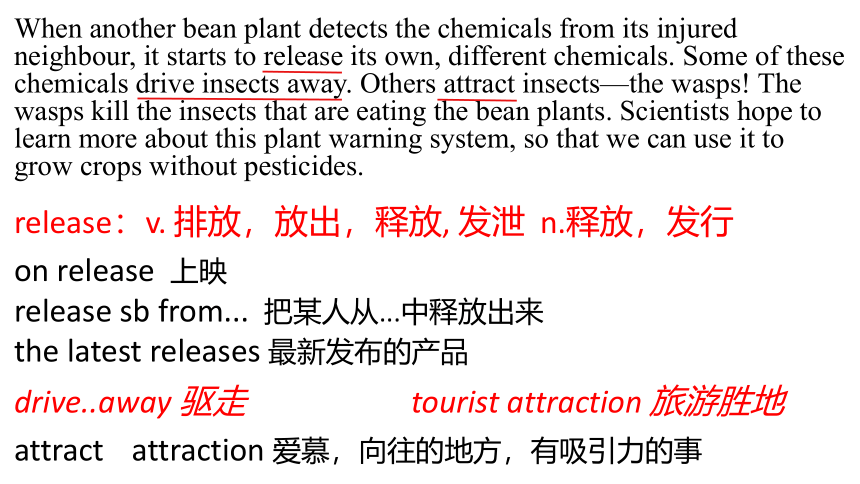外研版(2019)选择性必修一Unit 5 Revealing nature Developing ideas课件( 共14张)
文档属性
| 名称 | 外研版(2019)选择性必修一Unit 5 Revealing nature Developing ideas课件( 共14张) |  | |
| 格式 | zip | ||
| 文件大小 | 359.1KB | ||
| 资源类型 | 教案 | ||
| 版本资源 | 外研版(2019) | ||
| 科目 | 英语 | ||
| 更新时间 | 2022-08-28 13:30:04 | ||
图片预览







文档简介
(共14张PPT)
Unit 5 Revealing nature
Developing ideas
Read the passage and find out the
ways in which plants communicate.
They may communicate with each other by using chemicals, sound and even “wood wide web” system.
1. communicate with each other
2. from the leaves
3. release its own, different chemicals
4. with their roots
5. tell if a neighbouring plant is helpful, or unfriendly
6. clicking noises when there is not enough water, indicating drought is arriving.
7.the roots of different plants to each other
8. share information and even food
9.steal food from each other, or spread poisons
Talking plants have long been a thing of myths and legends. Many cultures have stories of talking trees that give advice as well as warnings to people. Alexander the Great and Marco Polo were said to have visited such a tree in India. And in some modern stories, such as the film Avatar, trees can communicate with animals and people.
as well as : and
sb be said to do
=It is said that sb...
It is said that he is the winner.
He is said to be the winner.
communicate with sb
With us long believing that talking plants are fantasy, new research has revealed something amazing: it appears that plants can communicate after all.
with复合结构
fantacy:a pleasant situation you imagine but that is unlikely to happen
幻想,想象
appear: seem
after all:1.毕竟 2.终究,结果,到底
It has been known for some time that plants use chemicals to communicate with each other. This happens when a plant, say a bean plant, gets attacked by insects. The plant releases tiny amounts of chemicals from the leaves that are being eaten. This is like a warning, or a call for help: “I’m being attacked!”
It is known that---It has been known that
say:for example.
比方说,假设,例如
tiny amounts of: 少量的
I'm being attacked.
=I'm ________ attack.
under
When another bean plant detects the chemicals from its injured neighbour, it starts to release its own, different chemicals. Some of these chemicals drive insects away. Others attract insects—the wasps! The wasps kill the insects that are eating the bean plants. Scientists hope to learn more about this plant warning system, so that we can use it to grow crops without pesticides.
release:v. 排放,放出,释放, 发泄 n.释放,发行
on release 上映
release sb from... 把某人从...中释放出来
the latest releases 最新发布的产品
drive..away 驱走
attract
attraction 爱慕,向往的地方,有吸引力的事
tourist attraction 旅游胜地
More surprisingly, plants also use sound to communicate. People can’t hear these sounds, but plants are making them. Some plants make noises with their roots. Corn and chilli plants do this. They also “listen” to the noises from other plants. A chilli plant can tell if a neighbouring plant is helpful, or unfriendly. Some trees make clicking noises when there is not enough water, indicating drought is arriving.
tell -- know/judge --- distinguish
tell the difference between
indicate: 暗示,表明,指明
There is indication that... 有迹象表明
Most surprisingly of all, plants have an amazing system of communication that link nearly every plant in a forest. Scientists call this system the “wood wide web”. It is in some ways similar to the Internet we use. While the Internet is a worldwide network of coputers linked by cables and satellites, the wood wide web is linked underground by fungi. This fungal network links the roots of differnet plants to each other.
link--connect
while 然而
Using the wood wide web, plants can share information and even food with each other. For example, some pine trees can send food to smaller pine trees to help them grow. But just like our own Internet, the wood wide web has its own version of “cybercrime”. Plants can steal food from each other, or spread poisons to attack other plants. Perhaps one day scientists will learn how to create a “firewall” to help prevent these attacks within the wood wide web.
version: 版本,型式
steal sth from sb
spread: 传播
1. The bird spread its wings.
2. He spread his arms.
3. The disease is spread by mosquitoes.
4. spread rumors/lies
张开
传播
散布
Scientists are learning more every day about the secret ways in which plants talk to each other. Who knows Maybe oneday we will know enough about plant communication to be able to “talk” with ourselves.
1. Personification. It can make descriptions more vivid.
2. “wood wide web” refers to an amazing system of communication that can link nearly every plant in a forest.
It is linked underground by fungi and this fungal network links the roots of different plants to each other.
3. It will help us know more about the world of plants and then get a better understanding of the secret of nature and encourage us to explore more about the mysterious nature. What’s more, it will teach us an important lesson, that is, human should live in harmony with mother nature. And it is our responsibility to fulfill the mission.
4.Passage 1 reveals the secret of evolution and Passage 2 reveals the secret of communication between plants. They all reflect that there are numerous secrets in nature that remain to be explored.
Read the observational journal and answer the questions.
How were the daffodil bulbs planted
They were planted side by side in soil with the pointed ends facing up.
2. In what environment did the leaves grow
The leaves grew in a sunny, but cool place.
3. What do the flowers look like
The flowers are yellow and white,and shaped
like trumpets.
Unit 5 Revealing nature
Developing ideas
Read the passage and find out the
ways in which plants communicate.
They may communicate with each other by using chemicals, sound and even “wood wide web” system.
1. communicate with each other
2. from the leaves
3. release its own, different chemicals
4. with their roots
5. tell if a neighbouring plant is helpful, or unfriendly
6. clicking noises when there is not enough water, indicating drought is arriving.
7.the roots of different plants to each other
8. share information and even food
9.steal food from each other, or spread poisons
Talking plants have long been a thing of myths and legends. Many cultures have stories of talking trees that give advice as well as warnings to people. Alexander the Great and Marco Polo were said to have visited such a tree in India. And in some modern stories, such as the film Avatar, trees can communicate with animals and people.
as well as : and
sb be said to do
=It is said that sb...
It is said that he is the winner.
He is said to be the winner.
communicate with sb
With us long believing that talking plants are fantasy, new research has revealed something amazing: it appears that plants can communicate after all.
with复合结构
fantacy:a pleasant situation you imagine but that is unlikely to happen
幻想,想象
appear: seem
after all:1.毕竟 2.终究,结果,到底
It has been known for some time that plants use chemicals to communicate with each other. This happens when a plant, say a bean plant, gets attacked by insects. The plant releases tiny amounts of chemicals from the leaves that are being eaten. This is like a warning, or a call for help: “I’m being attacked!”
It is known that---It has been known that
say:for example.
比方说,假设,例如
tiny amounts of: 少量的
I'm being attacked.
=I'm ________ attack.
under
When another bean plant detects the chemicals from its injured neighbour, it starts to release its own, different chemicals. Some of these chemicals drive insects away. Others attract insects—the wasps! The wasps kill the insects that are eating the bean plants. Scientists hope to learn more about this plant warning system, so that we can use it to grow crops without pesticides.
release:v. 排放,放出,释放, 发泄 n.释放,发行
on release 上映
release sb from... 把某人从...中释放出来
the latest releases 最新发布的产品
drive..away 驱走
attract
attraction 爱慕,向往的地方,有吸引力的事
tourist attraction 旅游胜地
More surprisingly, plants also use sound to communicate. People can’t hear these sounds, but plants are making them. Some plants make noises with their roots. Corn and chilli plants do this. They also “listen” to the noises from other plants. A chilli plant can tell if a neighbouring plant is helpful, or unfriendly. Some trees make clicking noises when there is not enough water, indicating drought is arriving.
tell -- know/judge --- distinguish
tell the difference between
indicate: 暗示,表明,指明
There is indication that... 有迹象表明
Most surprisingly of all, plants have an amazing system of communication that link nearly every plant in a forest. Scientists call this system the “wood wide web”. It is in some ways similar to the Internet we use. While the Internet is a worldwide network of coputers linked by cables and satellites, the wood wide web is linked underground by fungi. This fungal network links the roots of differnet plants to each other.
link--connect
while 然而
Using the wood wide web, plants can share information and even food with each other. For example, some pine trees can send food to smaller pine trees to help them grow. But just like our own Internet, the wood wide web has its own version of “cybercrime”. Plants can steal food from each other, or spread poisons to attack other plants. Perhaps one day scientists will learn how to create a “firewall” to help prevent these attacks within the wood wide web.
version: 版本,型式
steal sth from sb
spread: 传播
1. The bird spread its wings.
2. He spread his arms.
3. The disease is spread by mosquitoes.
4. spread rumors/lies
张开
传播
散布
Scientists are learning more every day about the secret ways in which plants talk to each other. Who knows Maybe oneday we will know enough about plant communication to be able to “talk” with ourselves.
1. Personification. It can make descriptions more vivid.
2. “wood wide web” refers to an amazing system of communication that can link nearly every plant in a forest.
It is linked underground by fungi and this fungal network links the roots of different plants to each other.
3. It will help us know more about the world of plants and then get a better understanding of the secret of nature and encourage us to explore more about the mysterious nature. What’s more, it will teach us an important lesson, that is, human should live in harmony with mother nature. And it is our responsibility to fulfill the mission.
4.Passage 1 reveals the secret of evolution and Passage 2 reveals the secret of communication between plants. They all reflect that there are numerous secrets in nature that remain to be explored.
Read the observational journal and answer the questions.
How were the daffodil bulbs planted
They were planted side by side in soil with the pointed ends facing up.
2. In what environment did the leaves grow
The leaves grew in a sunny, but cool place.
3. What do the flowers look like
The flowers are yellow and white,and shaped
like trumpets.
